Superluminescent LEDs offer distinct optical attributes compared to LEDs and laser diodes and are the preferred choice for imaging applications that call for reduced speckle and minimal interference noise.
CHRISTIAN VELEZ, EXALOS AG
Superluminescent light-emitting diodes (SLEDs) are broadband semiconductor devices that are closely related to their more commonly known relatives, laser diodes and light-emitting diodes (LEDs). All three architectures consist of positively (p)-doped and negatively (n)-doped sections and emit light through electrical current injection. The pn-junction of the semiconductor material is designed to produce a wide energy distribution of electron-hole pairs, which results in the emission of a broad range of optical frequencies from their recombination.

Superluminescent LEDs are used in fiber optic pressure sensors for static strain (load) or dynamic strain (vibration) measurements as well as temperature measurements in structures such as suspension bridges.
In the case of lasers, an optical waveguide and reflective facets are used to create a laser cavity (resonator), and amplified stimulated emission creates an edge-emitting device with a narrow band output. LEDs, on the other hand, have no amplified gain and emit light in all directions through spontaneous emission only. SLEDs, however, utilize an optical waveguide to exploit the process of amplified spontaneous emission (ASE) and single pass again, as opposed to multiple round-trips in a laser diode (Figure 1).
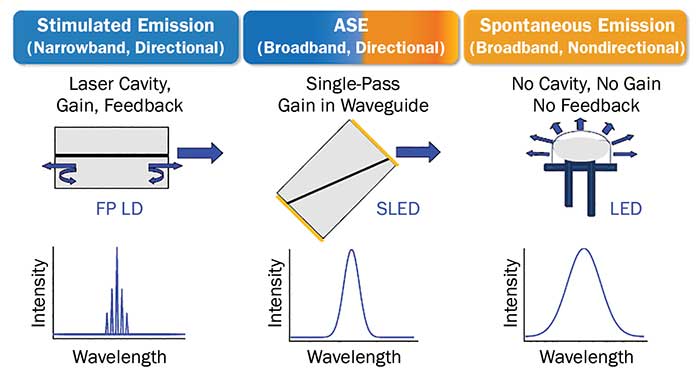
Figure 1. Comparison of SLED, laser diode and LED architectures. Courtesy of Exalos AG.
One of the key technology challenges in developing reliable SLED devices is achieving high optical output powers (over 100 mW) with a smooth spectral profile. The problem can be overcome with proprietary titled waveguide designs and the application of anti-reflection coatings to the facets (Figure 1) to suppress the cavity modes. Careful optimization of the modal gain has resulted in a wide range of near-IR product offerings based upon gallium arsenide (GaAs) and indium phosphide (InP) architectures packaged in standard uncooled transistor outline (TO) can and cooled butterfly-type enclosures (Figure 2).
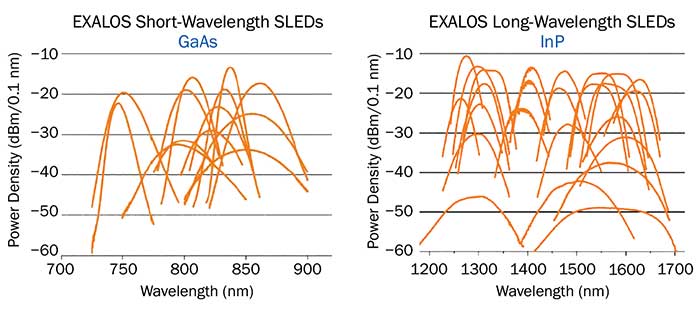
Figure 2. Representative power and spectral parameters of near-infrared SLEDs (available in standard transistor outline (TO) can and butterfly packages). Courtesy of Exalos AG.
Low temporal coherence
SLEDs have distinctive optical characteristics (Table 1) that essentially bridge the gap between the properties of laser diodes and LEDs. SLEDs, for example, emit an optical spectrum that is broad in the wavelength or frequency domain, which translates to a low temporal coherence or short coherence length. Conversely, they exhibit high directionality or spatial coherence that allows their output to be tightly focused and efficiently coupled into single-mode optical fibers. Their unique properties have proved to be valuable in a variety of diverse commercial applications.
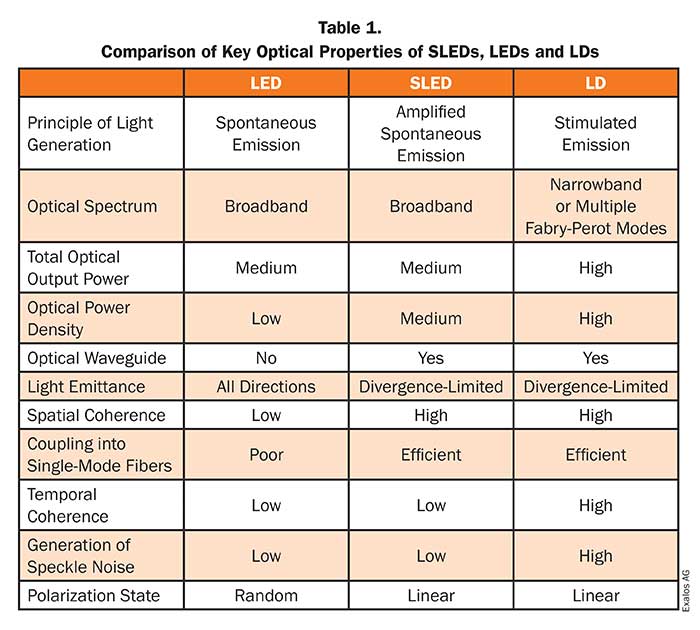
In some applications SLEDs are the preferred light sources because of their short temporal coherence, which significantly improves speckle or interference noise in imaging applications. In others, such as interferometric imaging applications, broadband SLEDs are used because of their coherence length of a few microns, which corresponds to the axial resolution of the imaging instruments. Other applications are not related to their coherence properties but rather their broad optical spectrum, focusability and high optical power or high spectral power density.
Preferred for OCT
Optical coherence tomography (OCT) is perhaps the most widely known application for SLED sources. This noninvasive imaging technique produces real-time, cross-sectional images with a resolution of a few microns. In just 20 years, it has become a well-established medical procedure in the fields of ophthalmology, cardiology, gastroenterology and dermatology, with a market size approaching $1 billion for system sales.
While swept source lasers have received much attention with the switch to higher resolution spectral domain (SD)-OCT about a decade ago, SLEDs still remain the preferred light source for most OEM applications because of their simplicity, compactness and cost.
OCT is often compared to ultrasound imaging with acoustic waves being replaced by light, which enables much higher resolution, albeit with much reduced depth of penetration. SD-OCT systems (Figure 3a) use SLEDs with a flat-top spectral shape and bandwidth of 50 to 100 nm. This low coherent light source is fed into both a sample and reference limb of either a Michelson or Mach-Zehnder interferometer. The OCT signal is collected by using a spectrometer and silicon detector array or a line-scan camera. The reference mirror is stationary and axial (A-scans) or depth information is achieved through Fourier transform of the spectral data into the spatial domain. Multiple adjacent A-scans are combined to create a cross-sectional image of the sample (B-scan).
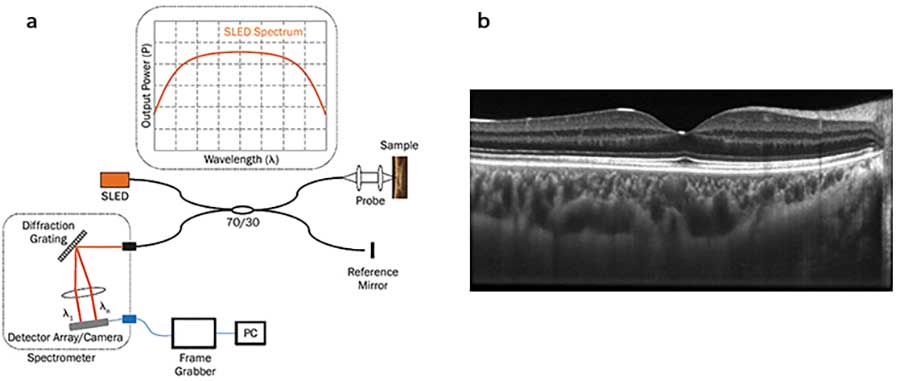
Figure 3. Generic setup of a spectral domain (SD)-OCT system with a reflective Michelson interferometer (a), 2D OCT cross section (B-scan) of a human retina, recorded with a 1070-nm broadband SLED source and a high-resolution spectrometer with an InGaAs camera (b). Courtesy of Professor Wolfgang Drexler, Center of Biomedical Engineering and Physics, Medical University of Vienna.
Today’s ophthalmic OCT systems use SLEDs in the 800- to 900-nm wavelength range for retinal applications and in the 1300-nm regime for corneal examinations. With 3-dB bandwidths of over 50 nm and 10-dB bandwidths of over 75 nm, the requirements on the light source in terms of spectral shape and constant spectral density are extremely demanding. Recently, the first 1060-nm broadband device was introduced, offering access to the low-absorption window of water and the promise of better penetration depth for cataract patients and those with opaque ocular media in the anterior segment of the eye.
Another key application for SLEDs is their use in navigation, primarily for avionics, aerospace and satellite systems that use fiber optic gyroscopes to make precise rotation measurements. Fiber optic gyroscopes measure the Sagnac phase shift of optical radiation propagating along a fiber optic coil when it rotates around the winding axis. When mounted within a navigation system, a fiber optic gyroscope tracks changes in orientation.
The basic components of a fiber optic gyroscope (Figure 4) include a SLED, a single-mode polarization-maintaining (PM) fiber coil, a coupler, a phase modulator and a detector. The reference light source is split and phase-modulated in two counter-propagating directions in a fiber coil. When the coil is at rest, the two light waves interfere constructively at the detector, and a maximum signal is produced at the demodulator. When the coil rotates, the two light waves have different optical paths that depend on the rotation rate or angular velocity of the coil. The phase difference between the two waves causes a variation in signal intensity at the detector and provides information on the rate of rotation.
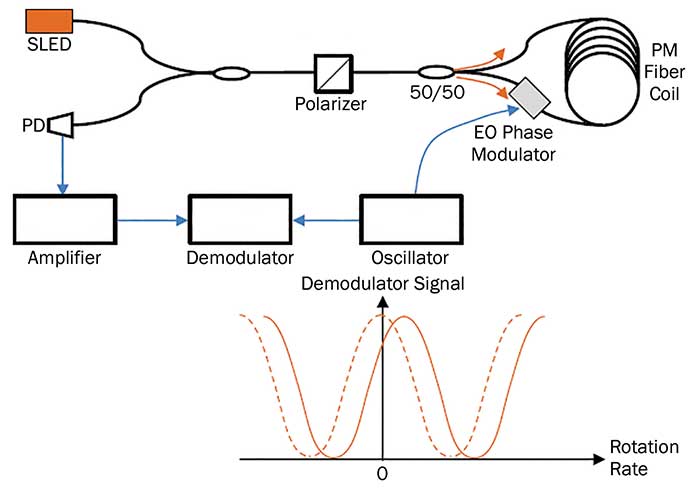
Figure 4. Generic setup of a fiber optic gyroscope (FOG). Courtesy of Exalos AG.
The key light source requirements for fiber optic gyroscopes are typically low cost, small form factor, low power consumption, long-term stability and high reliability. SLED-based gyroscopes rely on the large bandwidth of the source to reduce both the large Kerr-induced drift and the high coherent backscattering noise along the fiber. In addition, the source must support reliable performance over a very broad temperature range with optimum signal-to-noise, particularly at very low rotation rates.
SLED sources, such as those from Exalos AG, offer low-amplitude noise with relative intensity noise (RIN) levels of −120 dBc/Hz. Further, the stringent environmental requirements have been addressed by using novel materials and material structures to reduce the wavelength temperature sensitivity. Sources currently under development are targeting wavelength stabilities as low as 10 parts per million, packaged and tested according to aerospace requirements.
Another photonics market sector employing SLEDs is fiber-optic sensing, which has experienced double-digit compounded annual growth over the past decade. Optical fibers offer advanced functionality through their intrinsic sensitivity to temperature, pressure and strain and are able to provide a wide range of system performance parameters, from measuring the structural integrity of infrastructure to providing haptic feedback in robotic surgery equipment. When used in conjunction with a reference light source, the capability of these monitoring fiber networks can be significantly enhanced.
SLEDs are used in fiber optic pressure sensors for static strain (load) or dynamic strain (vibration) measurements as well as temperature measurements in civil engineering, structural analysis and composite material manufacturing applications. Fiber optic sensors offer significant advantages in terms of size, weight, immunity to electromagnetic fields, multi-point detection, embedded implementation, etc., versus traditional technologies such as electrical strain gauges.
Various optical system architectures have been developed such as time-domain systems, which rely on propagation delays between the source and wavelength-specific fiber sensors, or wavelength-domain systems, which measure the change in reflectivity of a specific spectral region. Figure 5 shows a generic setup of a wavelength-multiplexed fiber sensor system using a broadband SLED, typically in the high transmission 1550-nm range of silica fibers, and a reflective sensor system incorporating various wavelength-specific fiber Bragg gratings (FBGs). Alternatively, the FBG sensors may be incorporated into multiple arms for a network of spatially distributed sensors.
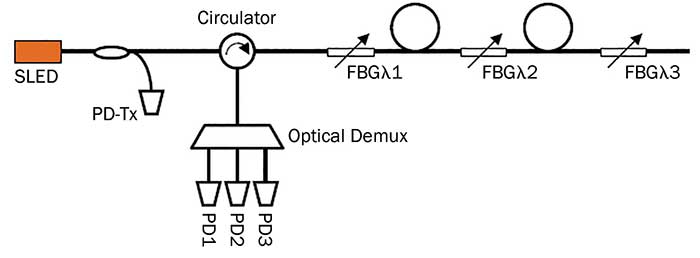
Figure 5. Wavelength-domain-distributed fiber Bragg grating (FBG) sensor system using wavelength division multiplexing with a broadband SLED. Courtesy of Exalos AG.
The SLED source characteristics of temperature insensitivity, broad emission wavelength and high power enable the use of these fiber optic sensors for strain measurements in civil engineering structures as well as temperature and pressure sensors in hostile environments. A range of 1550-nm SLEDs are well-suited for this application with wide optical spectrum (60- to 90-nm bandwidth) and high spectral power
density (average powers of 5 to 20 mW). Recently, an unpolarized 1550-nm version has been introduced that provides significant benefit in interrogating an FBG.
From spectroscopic monitoring to machine vision
While SLEDs are already firmly established as the preferred source across a wide range of market sectors, new applications include connected continuous spectroscopic monitoring for averting environmental disasters, remote monitoring of pipelines and verifying impurity levels of reagents in the chemical industry. SLEDs are the ideal light sources for the new generation of compact, highly sensitive spectrometer systems under development. Their broadband near-infrared output overlaps well with the absorption spectrum of not only greenhouse gases such as carbon dioxide (CO2) and methane (CH4) but also chemically reactive gases like ozone (O3) or oxides of sulfur or nitrogen (SO2 or NOx).
Similarly, with the strong growth in process automation, machine vision, 3D sensing and imaging, there is an uptick in the interest in SLEDs as potential illumination sources. While these applications have traditionally been the realm of laser diodes or LEDs, the demands for greater precison, higher speed and throughput are pushing the limits of the incumbent light sources. LEDs with their broad Lambertian emisson can struggle to meet the illumination requirements while the strong coherence of laser sources can create undesirable speckle effects. This has opened up new market opportunities for SLEDs.
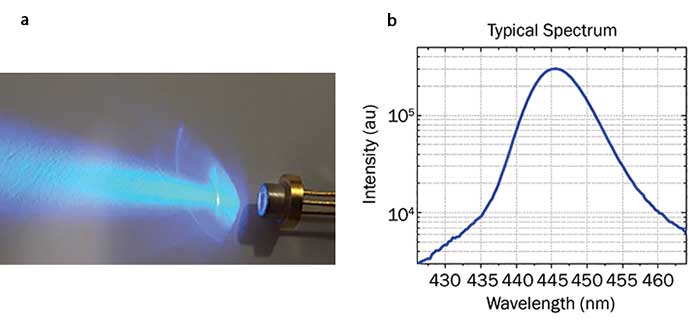
Figure 6. Blue SLED (a); Blue SLED spectral range (b). Courtesy of Exalos AG.
On the technology front, the challenge is to increase the wavelength capabilties of SLEDs with different material systems both to shorter visible and longer mid-infrared wavelengths. Figure 6 shows the output of a blue gallium nitride (GaN) SLED with its corresponding spectral distribution. Like the current generation of near-infrared devices, these visible sources offer the benefit of high directionality (high spatial coherence) and low speckle noise (low temporal coherence). As a result, they are ideal sources for projection or color sequential illumination of liquid crystal on silicon and DLP-based micro-displays. In additon, they offer an attractive alternative to visible lasers in applications such as microscopy, spectroscopy or machine vision, where coherent artifacts can be problematic. Further development is required to offer a full suite of red, green, blue sources, but the prospects are encouraging.
Meet the author
Christian Velez received his master’s degree and his Ph.D. in physics from ETH Zurich. After several years at Opto Speed in Switzerland, he founded Exalos AG in 2003.